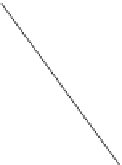Graphics Reference
In-Depth Information
Filtering
Rendering
Neighboring
pixels
Texture
Weight
{
R
(
r
)
T
(
r
)
Scaled
Scaled
Incident light
Exitant light
p
i
p
o
r
Figure 4.22
An albedo map works like a texture map, except that it is convolved with the reflectance
profile. This acts as a filter.
therefore is lost. However, this unreflected light becomes the incident light for
subsurface scattering. The authors use a complementary average diffuse BRDF
to determine the amount of light entering the surface.
The rendered images of human skin are a compelling result of Donner and
Jensen's 2005 paper. In the paper, skin is modeled as a three-layeredmedium con-
sisting of the epidermis, the upper dermis, and the bloody dermis. The first two
layers are highly scattering and quite thin; the bottom layer is treated as being in-
finitely deep and exhibits a much lower degree of scattering. Figure 4.23(a)-(e) il-
lustrates each reflectance and transmittance profile as a shading of a
human head model. Note that the transmittance is more significant than the re-
flectance (the bloody dermis layer has no transmittance, as it is infinitely deep).
The three layers are convolved as described above to form the multilayer dif-
fuse reflectance profile, which is shown in Figure 4.23(g). An illustration of
the BRDF used to model the surface roughness of human skin is contained in
Figure 4.23(f).































































































